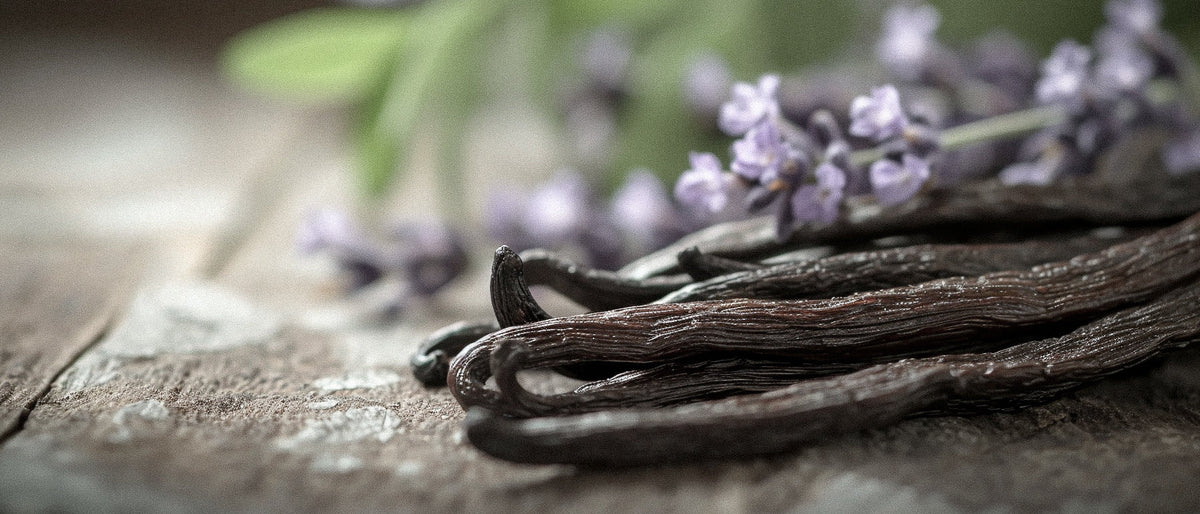
The Vanilla Renaissance: Exploring the Heart of Natural Perfume and Niche Fragrance
|
|
Time to read 11 min


|
|
Time to read 11 min
Ever caught a whiff of vanilla and found yourself instantly transported to a cozy memory? That’s the magic of this extraordinary ingredient—a cornerstone in both natural perfume and the world of niche fragrance. While vanilla might seem familiar, even commonplace, its role in perfumery is anything but simple. It’s a complex, multifaceted note that has captivated perfumers and fragrance lovers alike for centuries.
I’ve spent years exploring the fascinating intersection of science and art in perfumery, and vanilla continues to surprise me with its depth and versatility. Whether you’re a fragrance aficionado or simply curious about what makes your favorite scent so captivating, join me on this sensory journey through the world of vanilla perfumery.
The allure of natural perfume isn’t just about marketing—it’s rooted in chemistry. When we talk about vanilla in perfumery, we’re really discussing a complex orchestra of molecules, with vanillin playing first chair. Recent research has identified at least 24 distinct chemicals in vanilla fragrance oils, each contributing to that rich, multidimensional scent we recognize.
What makes vanilla so special in natural perfume creation is its remarkable stability. Scientific studies using the innovative Perfumery Ternary Diagram have shown that vanillin maintains its integrity at lower concentrations, making it an excellent fixative—a component that helps other, more volatile notes last longer on the skin. This is why vanilla is often found in the base notes of a fragrance, providing that long-lasting foundation that keeps your scent going throughout the day.
Temperature plays a fascinating role in vanilla’s aromatic profile. Research has revealed that vanilla beans stored at −20°C for six months develop the highest levels of vanillin, while storage at warmer temperatures (around 35°C) creates noticeable shifts in the aroma profile. This sensitivity to environmental conditions is part of what makes natural vanilla such a dynamic ingredient in perfumery.
The world of natural perfume oils is particularly reliant on vanilla’s fixative properties. These concentrated formulations skip the alcohol base found in traditional perfumes, allowing the true character of botanical ingredients to shine through. When vanilla is included in natural perfume oils, it creates a rich foundation that anchors more fleeting notes while adding its own distinctive warmth.
The niche fragrance market has embraced vanilla with particular enthusiasm, elevating it from a simple, sweet note to a sophisticated element in complex compositions. But what is niche fragrance, exactly? Unlike mass-market perfumes designed to appeal to the broadest possible audience, niche fragrance prioritizes artistic vision, quality ingredients, and unique compositions that tell a story.
The difference between niche vs designer fragrance often comes down to creative freedom. While designer brands must create scents with wide commercial appeal, niche perfumers can explore vanilla’s full range of possibilities—from its creamy sweetness to its woody, leathery, or even boozy facets. This artistic liberty has led to some of the most innovative interpretations of vanilla in modern perfumery.
The appeal of niche perfume lies in its uniqueness and attention to detail. When a niche perfumer works with vanilla, they’re not just adding sweetness—they’re exploring the ingredient’s full potential, often highlighting aspects that might be overlooked in mainstream fragrances. This dedication to craftsmanship and quality is what draws many fragrance enthusiasts to the niche market.
The growing consumer preference for clean, sustainable products has fueled significant growth in the natural perfume sector, with natural vanilla perfume emerging as a particular favorite. Unlike synthetic vanillin (which dominates the mass market), natural vanilla extracts offer a richer, more nuanced scent profile that changes and evolves on the skin.
What makes a natural vanilla perfume special isn’t just the absence of synthetic ingredients—it’s the presence of vanilla’s full spectrum of aromatic compounds. Natural extraction methods preserve delicate components that might be lost in synthetic recreation, resulting in a more complex, authentic vanilla experience. This richness is why many perfume connoisseurs specifically seek out natural vanilla formulations.
The market for natural perfume has shown impressive growth, with projections suggesting it will continue to expand. Current market value stands at approximately $29.20 billion, with forecasts indicating growth to $45.16 billion by 2032—a compound annual growth rate of 5.6%. This expansion reflects increasing consumer interest in natural ingredients and sustainable practices.
Pairing vanilla with citrus creates a beautiful contrast between warm and fresh elements. The molecular interaction between vanillin and compounds like limonene (found in citrus oils) creates a vibrant, uplifting effect while maintaining depth and longevity.
When layering vanilla with citrus, try applying the citrus element first, allowing it to settle for a few minutes before adding your vanilla fragrance. This sequencing allows the bright, volatile citrus notes to shine initially, while the vanilla emerges gradually as the day progresses. The result is like sunshine breaking through warm clouds—radiant and uplifting.
Woody notes like sandalwood, cedar, and vetiver complement vanilla’s warmth while adding sophistication and depth. This combination works particularly well in niche perfume compositions, where the quality of both the vanilla and woody components allows for a more nuanced interaction.
The molecular affinity between vanillin and woody compounds creates a seamless blend that feels natural and harmonious. This pairing often results in fragrances that transition beautifully from day to evening, maintaining their character while evolving subtly over time.
White florals like jasmine, tuberose, and orange blossom create an elegant counterpoint to vanilla’s sweetness. The indolic qualities of these flowers (a slightly animalic facet) interact with vanilla’s creaminess to create a complex, sophisticated accord.
This combination appears frequently in high-end natural perfume compositions, where the quality of the floral absolutes can truly shine against vanilla’s smooth backdrop. The result is often described as “radiant”—a fragrance that seems to project in multiple directions simultaneously.
Spices like cinnamon, cardamom, and pink pepper bring energy and dimension to vanilla compositions. The interaction between vanillin and compounds like cinnamaldehyde creates a warming effect that’s particularly appealing in cooler weather.
Many natural perfume oils feature this combination, allowing the concentrated format to showcase the rich interplay between spice and sweetness. The absence of alcohol in these formulations often results in a more intimate, skin-scent effect that evolves beautifully throughout the day.
Amber—a blend of labdanum, vanilla, and benzoin—creates a golden, radiant quality when paired with additional vanilla notes. This combination appears frequently in both natural perfume and niche fragrance compositions, offering warmth and longevity.
The complementary nature of these materials creates a seamless blend that feels cohesive and balanced. This pairing works particularly well in fall and winter, when its enveloping quality provides comfort and sophistication.
Clean musk notes extend vanilla’s presence on the skin while adding a subtle sensuality. This combination creates what perfumers call “trail”—the lingering scent that follows you throughout the day.
Many natural perfume brands are exploring plant-based musk alternatives that pair beautifully with vanilla. These clean formulations offer the sensual quality of traditional musks without synthetic ingredients, appealing to health-conscious consumers seeking natural alternatives.
Gourmand elements like caramel, chocolate, and coffee enhance vanilla’s edible qualities while adding complexity and depth. This combination has gained particular popularity in niche fragrance creations that balance indulgence with sophistication.
The key to a successful gourmand vanilla is balance—the composition should suggest deliciousness without becoming cloying or overly literal. The best examples offer a sophisticated interpretation of edible notes rather than a straightforward food recreation.
The vanilla market shows significant growth potential, with projections indicating expansion from $29.20 billion in 2024 to $45.16 billion by 2032. This growth reflects increasing consumer interest in both natural ingredients and unique, artisanal creations.
Several factors are driving innovation in vanilla perfumery:
Beyond its chemical properties and market potential, vanilla’s enduring appeal lies in its emotional resonance. The connection between scent and memory is well-documented, with the olfactory system linking directly to the limbic system—the part of our brain responsible for emotion and memory.
Vanilla’s familiarity makes it particularly effective at triggering emotional responses. For many people, it evokes comfort, warmth, and security—associations that begin forming in childhood and continue to evolve throughout life. This emotional dimension helps explain why vanilla remains consistently popular despite changing fragrance trends.
The complexity of natural vanilla allows for a particularly rich emotional experience. The multiple facets of the scent—from creamy sweetness to woody depth—create a multidimensional impression that evolves over time. This evolution keeps the experience interesting, allowing you to discover new aspects of the fragrance throughout the day.
From scientific analysis to market trends, our exploration of vanilla in perfumery reveals a fascinating ingredient that continues to captivate and inspire. Its presence in both natural perfume and niche fragrance creations speaks to its versatility and enduring appeal.
What makes vanilla truly special is its ability to be simultaneously familiar and surprising—comforting yet complex. Whether you’re drawn to the authentic richness of natural vanilla perfume or the artistic interpretations found in niche fragrance compositions, there’s always something new to discover in this remarkable ingredient.
As consumer interest in quality, sustainability, and uniqueness continues to grow, vanilla’s prominence in perfumery seems assured. The projected market growth, coupled with ongoing innovations in sourcing and extraction, suggests that we’re entering a new golden age for vanilla in fragrance—a renaissance that honors tradition while embracing the future.
The next time you experience a vanilla-centered fragrance, take a moment to appreciate the extraordinary complexity behind that seemingly simple note. From the chemistry that creates its distinctive aroma to the artistry that showcases its many facets, vanilla represents perfumery at its most magical—science and art working in perfect harmony to create something truly beautiful.
Teixeira, M. A., Rodríguez, O., & Rodrigues, A. E. (2010). Perfumery radar: A predictive tool for perfume family classification. Industrial & Engineering Chemistry Research, 49(22), 11764-11777.
Pérez-Silva, A., Odoux, E., Brat, P., Ribeyre, F., Rodriguez-Jimenes, G., Robles-Olvera, V., García-Alvarado, M. A., & Günata, Z. (2006). GC–MS and GC–olfactometry analysis of aroma compounds in a representative organic aroma extract from cured vanilla (Vanilla planifolia G. Jackson) beans. Food Chemistry, 99(4), 728-735.
Surburg, H., & Panten, J. (2016). Common fragrance and flavor materials: Preparation, properties and uses. John Wiley & Sons.
Fortineau, A. D. (2004). Chemistry perfumes your daily life. Journal of Chemical Education, 81(1), 45.
Kraft, P., Bajgrowicz, J. A., Denis, C., & Fráter, G. (2000). Odds and trends: recent developments in the chemistry of odorants. Angewandte Chemie International Edition, 39(17), 2980-3010.
Herz, R. S. (2016). The role of odor-evoked memory in psychological and physiological health. Brain Sciences, 6(3), 22.
Turin, L., & Sanchez, T. (2008). Perfumes: The A-Z guide. Profile Books.
Pybus, D. H., & Sell, C. S. (1999). The chemistry of fragrances. Royal Society of Chemistry.
Grand View Research. (2024). Vanilla Market Size, Share & Trends Analysis Report By Type (Conventional, Organic), By Form (Liquid, Powder, Paste), By Application (Food & Beverages, Personal Care, Pharmaceuticals), By Region, And Segment Forecasts, 2024-2032.
Precedence Research. (2024). Fragrance Market Size, Share, Growth, Trends Analysis Report By Product Type (Natural, Synthetic), By Application (Fine Fragrance, Cosmetics, Toiletries, Home Care), By Distribution Channel (Online, Offline), By Region, And Segment Forecasts, 2024-2037.